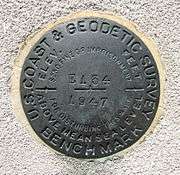Benchmark (surveying)

The term bench mark, or benchmark, originates from the chiseled horizontal marks that surveyors made in stone structures, into which an angle-iron could be placed to form a "bench" for a leveling rod, thus ensuring that a leveling rod could be accurately repositioned in the same place in the future. These marks were usually indicated with a chiseled arrow below the horizontal line.
The term is generally applied to any item used to mark a point as an elevation reference. Frequently, bronze or aluminum disks are set in stone or concrete, or on rods driven deeply into the earth to provide a stable elevation point. If an elevation is marked on a map, but there is no physical mark on the ground, it is a spot height.
The height of a benchmark is calculated relative to the heights of nearby benchmarks in a network extending from a fundamental benchmark. A fundamental benchmark is a point with a precisely known relationship to the level datum of the area, typically mean sea level. The position and height of each benchmark is shown on large-scale maps...
The terms "height" and "elevation" are often used interchangeably, but in many jurisdictions they have specific meanings; "height" commonly refers to a local or relative difference in the vertical (such as the height of a building), whereas "elevation" refers to the difference from a nominated reference surface (such as sea-level, or a mathematical/geodetic model that approximates the sea level known as the geoid). Elevation may be specified as normal height (above a reference ellipsoid), orthometric height, or dynamic height which have slightly different definitions.
Other types of survey marks

Triangulation points, also known as trig points, are marks with a precisely established horizontal position. These points may be marked by disks similar to benchmark disks, but set horizontally, and are also sometimes used as elevation benchmarks. Prominent features on buildings such as the tip of a church spire or a chimney stack are also used as reference points for triangulation. In the United Kingdom triangulation points are often set in large concrete markers that, as well as functioning as triangulation points, have a benchmark set into the side. With the increasing use of GPS and electronic distance measuring devices, the same techniques and equipment are used to fix the horizontal and vertical position of a survey marker at the same moment, and therefore the marks are usually regarded as "fixed in three dimensions".
Agencies responsible for benchmarks
Benchmarks are typically placed ("monumented") by a government agency or private survey firm, and many governments maintain a register of these marks so that the records are available to all. These records are usually in the form of a geographically searchable database (computer or map-based), with links to sketches, diagrams, photos of the marks, and any other technical details.
Government agencies that place and maintain records of benchmarks include:
- Natural Resources Canada (Geodetic Survey Division)
- The National Geodetic Survey (NGS; formerly U.S. Coast & Geodetic Survey)
- The United States Army Corps of Engineers (USACE)
- The United States Forest Service
- The United States Geological Survey (USGS)
Image gallery
-

C&GS benchmark disk in the United States.
-

Bench mark at Saint Goussaud, Limousin, France, by Institut Géographique National.
See also
| Wikimedia Commons has media related to Trig points and benchmarks. |
| Wikisource has the text of the 1911 Encyclopædia Britannica article Bench-mark. |
- Benchmarking—a recreational activity in which participants search for benchmarks using a handheld GPS receiver.
- Broad arrow
- Geoid
- Levelling—a surveying technique that utilises benchmarks
- Spot height
External links
- Canadian Spatial Reference System
- History of the Canadian Geodetic Survey Division
- Istituto Geografico Militare - Servizio Geodetico
- Survey of Pakistan
- UK benchmark database
- Detailed description of the different types of UK benchmark
- US NGS Benchmarks overlaid on a Google Map
- Benchmarks and levelling points
